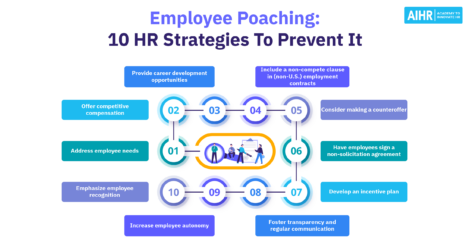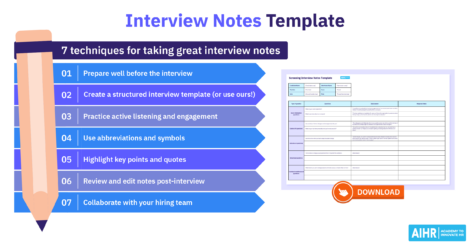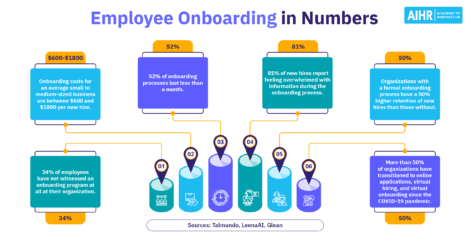The 15 Best Recruitment Methods You Have to Know

Recruitment methods have been studied since the 1920s. In this article, we will give an overview of the 15 most common recruitment methods. We will also explore how good these methods are at predicting whether or not a candidate will be a good fit based on the latest research.
One of the studies that we will often refer in this article, is Schmidt and Hunter’s 1998 article on the validity of selection methods. This article summarizes “85 Years of Research Findings” in a meta-analysis (an analysis that combines the data of multiple studies). We have also included a number of more contemporary studies about this topic.
Contents
- IQ Tests
- Unstructured employment interview
- Structured employment interview
- Work sample tests
- Job knowledge tests
- Integrity tests
- Conscientiousness tests
- Peer ratings
- Reference checks
- Improving job postings
- Employee referrals
- Gamification
- Video job postings, applications and interviews
- AI-based screening process
- Hiring freelancers and contractors
#1 IQ Tests
Our number one recruitment method is the IQ test or General Mental Ability (GMA) test.
IQ testing is, arguably, the most well-validated concept in social sciences. Whether we like it or not, your IQ is the best predictor of your academic success, learning abilities, how successful you are in your work, and how much money you will make in your life.
Because IQ is not related specifically to job knowledge, it can be used to hire for any position, whether in IT or marketing, whether senior or entry level.
The interesting thing is that IQ is indicative of two things when it comes to work. First, it predicts how quickly a candidate will learn a job. This means that candidates with a higher IQ score will have a shorter ‘time to productivity’, a metric that measures how long it takes a new hire to contribute to an organization. Second, it predicts how successful a candidate will be in their job.
Of course, IQ isn’t everything.
According to a meta-analysis by Schmidt & Hunter (1998), GMA predicts up to 26% of the job performance of a candidate. This still leaves 74% open for interpretation!
Although GMAs are commonly seen as an effective tool, there are a number of studies which have also questioned how useful they are based on job role/industry and fairness of the tests themselves. Overall, while GMAs are still a great tool for predicting future success, decisions shouldn’t be made based on these results alone and should always be combined with other recruitment methods to balance the potential disadvantages.
#2 Unstructured employment interviews
There’s no doubt you’re probably already using interviews in your hiring process. But did you know that the way you structure your interviews can have a major impact on how effective they are?
Many companies, especially young startups, and SMBs have little time to come up with a structured review process.
Instead, they leave it up to hiring managers to come up with their own questions and means of assessment. But, if you’re using unstructured interviews now, it’s time to stop! When looking at Schmidt and Hunter’s meta-analysis, we can see a major difference in the validity of unstructured (.38) vs. structured interviews (.51).
This means that unstructured interviews predict roughly 14% of a new hire’s performance, while a structured interview predicts 26%! This means that you would need around 3 unstructured interviews in order to be as confident about someone’s skills, compared to 1 structured interview.
Unstructured interviews lead to hiring decisions based on gut instinct, rather than a fair and equal comparison. A number of studies have found that, when interviews are unstructured, it’s more likely that certain candidates can be favored based on the biases of the interviewer. Unconscious bias is more common than you may think and can greatly damage your recruitment efforts. Instead, having a set list of questions that every candidate must answer improves the chances of a fair assessment.
#3 Structured employment interviews
Combining structured interviews with a GMA test was the second highest predictor of future performance in Schmidt and Hunter’s meta-analysis. Precisely because structured interviews mean that applicants are assessed and scored based on the same questions, they’re considered significantly more valid in terms of predicting future success. Studies show that comparing candidates based on the same criteria lowers the chances of a biased interview.
What’s more, taking the time to research the right questions for your interview process will help you make better hiring decisions. Always striving to make their processes data-driven, tech giant Google even analyzes the data behind its past interview questions. Recently the company decided to drop its infamous brainteasers after finding that the answers didn’t provide any insights into future job success.
A famous example of a brain teaser is “why are manhole covers round?”
While face-to-face or phone interviews may be a great way to see how a person expresses themselves and presents their qualifications, they don’t tell us everything. The fact is, some people are much better at selling themselves and their abilities than others. Are we passing up great talent just because they aren’t comfortable in interviews?
#4 Work sample tests
Asking for a short assignment is a great way to see a potential hire’s skills in action. Event organizers are commonly asked to draw up a fake event strategy to see how much forethought they put into their planning. Content marketers are usually given a short writing task to get a sense of their style. You can even hold group work sample tests to see how different people are able to interact and get a job done.
But is this an ideal method?
According to Schmidt and Hunter, the use of work sample tests is one of the best ways to find how well a candidate will perform in their job. It is just as effective as a structured interview!
However, one potential drawback is that they may not be effective when hiring candidates who don’t have previous experience. Today people are continuously changing career paths. Especially in new or hard to fill roles, it’s necessary to be open to candidates who may not have the skills they need yet but who have the learning agility they need to grow, develop and adapt with the needs of the organization.
#5 Job knowledge tests
Instead of just testing one aspect of a candidate’s abilities, job knowledge tests allow you to get a wider picture of a person’s role-specific expertise. Unlike a GMA, there is no attempt to assess the applicant’s learning potential. Job knowledge can be used to inform the hiring manager about what an applicant already knows.
Job knowledge tests traditionally focus on procedural knowledge (if situation x occurs, which procedure should be used in response?) A 2005 study points out that job knowledge tests have traditionally been better at predicting performance in military-related jobs which focus heavily on these procedures. Instead, the authors expanded their tests to include decision-making information.
As a result, they found that a job knowledge test may actually provide a better prediction of future performance than cognitive ability tests.
If you decide to use this method, consider the types of questions you’re asking and what the role requires. Again, like work sample tests, job knowledge is harder to test for hires who don’t have prior experience. However, it does enable you to test whether or not candidates have a solid understanding of the job they applied for.
Some believe that methods like IQ tests, interviews, and job knowledge tests don’t go far enough in giving us a true understanding of the applicant’s character and their ability to adapt and thrive in the work environment. The next two methods provide testing that goes beyond intelligence and job knowledge.
#6 Integrity tests
What a GMA test, interview or job knowledge screening won’t tell you are the behavioral traits of an applicant. Someone may be very intelligent and skilled in a particular field but they may not have the soft skills they need to work in a team, or they may even have a tendency towards toxic behaviors. Integrity testing identifies a person’s propensity for honesty, trustworthiness, and dependability.
By using this sort of assessment, companies try to select talent that has a higher likelihood of displaying positive behavior in the workplace.
And the results are positive.
In Schmidt and Hunter’s study, the integrity test on its own predicted 17% of future performance. When combined with the GMA test, it predicted 42% of future performance!
Although this method is highly effective, it is good to be aware of the drawbacks.
One of them being the acceptability and fairness of the assessment.
The use of Integrity test results in hiring decisions raises ethical questions. Should we be using a self-assessment like this to measure a person’s honesty? What about the possibility of false positives? What’s more, those who are rejected on the basis of the test may feel they’re being labeled as ‘dishonest’. Good communication of test results is therefore key for a good candidate experience.
This brings us to the second problem, the need for trained test administrators. Untrained test givers can exacerbate the fairness issue by misinterpreting or misclassifying the results.
#7 Conscientiousness tests
Similar to integrity tests, conscientiousness testing measures a person’s level of self-discipline and reliability through organizational skills and the ability to create long term goals. Personality tests like the NEO-PI Big Five and the MBTI are some of the most popular methods.
Personality traits are indicative of work behavior. Of the Big Five, especially conscientiousness is related to better job performance. People who are conscientious are described as orderly, dutiful, achievement striving, self-disciplined, and industrious.
Because personality traits and IQ are two very different things, a combination of GMA testing and a conscientiousness test is able to predict 36% of job performance.
Of the other personality traits, only extraversion seems somewhat related to performance. For example, both conscientiousness and extraversion are positively related to sales performance.
#8 Peer ratings
Another avenue some recruiters use to find candidates who will be both a great fit for the team and top performers is peer ratings. Today more and more companies are using peer feedback to assess job performance. Unlike traditional manager to employee performance reviews, peer ratings provide a well-rounded picture of a person’s abilities.
Unlike integrity and conscientiousness testing, both based on self-assessment alone, these results allow us to get an idea of how the candidate is perceived by the people they work with directly.
Of course, it’s only possible to use this method for internal hires who already have a history of peer-review data. There are also concerns that peer-reviews may be influenced by factors like popularity.
Peer reviews are increasingly used by
companies to assess job performance.
#9 Reference checks
Reference checks are one of the oldest recruitment methods in the book. And it makes sense. If you want to know more about a potential candidate, who better to ask than their previous employer?
In fact, a peer-reviewed study by Skillshare found that reference feedback is predictive of first-year involuntary turnover.
However, for such a widely used method, Schmidt and Hunter’s research found that reference checks only predict job performance by about 7%. There are a number of considerations to take into account when using this method.
As with interviews, when using references as a recruitment method, we have to consider the potential for bias. Studies show that 62% of a rater’s judgment is a reflection on themselves. In other words, the perception we have of another person and their performance will be altered by our own standards and values. References can be helpful, but be sure to use this method in conjunction with other, more predictive assessments.
So far, we’ve gone through the most popular and well-researched methods to date but, in order to really find the right recruitment methods for your needs, we also need to consider some of the modern challenges which could be impacting your search.
#10 Improving job postings
Improving diversity is a major challenge many HR managers are facing. Having a deeper look at our recruitment methods could provide some answers and help with diversity hiring.
We shouldn’t just be looking at the methods used to assess each applicant, we should also consider the methods we’re using to attract candidates in the first place. The ways we advertise a position and our organization can actually have a major impact on the candidates who apply.
The language we use is especially important.
A number of studies have found that the wording we use can sometimes discourage certain groups from applying for a job. This can be based on gender, ethnicity, age, introverts, extroverts, parents, etc. But we’re now seeing a number of tools emerging, such as Textio and Gender Decoder, to help us detect potential bias in our job adverts. One study found that when gendered wording is eliminated from job adverts, recruiters will actually see a 42% increase in applicants.
#11 Employee referrals
Your company actually has a much wider network than you realize. Instead of focusing only on candidates who come in through the typical job portal, leverage your employee ambassador network to find your next hire.
Surveys have shown that employee referrals reduce cost and time per hire and have the highest ROI of any other recruitment method. New talent that comes in via a referral is also more likely to stay longer at their jobs. In fact, a survey by Deloitte found that 51% of organizations say employee referrals are the number one recruitment source. Some companies are maximizing the potential of this method by offering employee bonuses for each new hire they bring in.
As with all methods, there is a downside.
Employee referrals may impact the diversity within your organization. An employee’s network will most likely be made up of people who are similar to them, whether they share the same social circle, live in the same neighborhood or went to the same university. A recent study by BCG reported that organizations with above-average diversity on their management teams also reported a 19-percentage point higher revenue on new products and services launched over the past three years.
Referrals have both their advantages and disadvantages.
#12 Gamification
Recruiters working in the tech industry have a particularly difficult time. Tech talent is in extremely high demand and traditional recruitment methods are often less effective with this group of candidates. Rounds of interviews, tests, and assessments are not something these hires, especially the younger ones, are willing to go through.
Instead, many companies have turned the tables and rethought how they can make the recruitment process more fun for applicants and more effective for companies. A good example are hackathons. Similar to situational group interviews, hackathons allow recruiters to see how developers interact with others, solve problems, and how they put their skills into action.
Other applications include gamified assessments. The verdict on their reliability is still out there. Although some claim to be very good at predicting performance, they are usually tested by the company itself so results should be interpreted with caution.
#13 Video job postings, applications and interviews
In today’s interconnected world, companies aren’t limiting themselves to local talent pools. International hiring is now becoming the norm. But this can also impact the effectiveness of some of the more traditional recruitment methods we discussed.
In the digital world, video-based job ads, applications, and interviews are becoming more popular. Indeed, video-based job ads on Facebook receive 36% more applicants. After switching to a video-based recruitment process, Hilton was able to cut their hiring time from six weeks to five days.
#14 AI-based screening process
New advances in AI technology and automation are here to save recruiters from having to sift through resume after resume. In fact, you could be losing 14 hours a week by not automating some of your tasks.
There are various intriguing uses of AI in recruitment, varying from automated candidate sourcing and candidate rediscovery to candidate matching and preselection and everything in-between. Pre-employment assessment tools often combine (elements of) GMA, work sample, integrity and conscientiousness tests in a single online experience to predict a candidate’s likelihood to succeed in the job their applying for.
Put very simply, AI works by analyzing historical data and using it to make decisions. Sometimes, in case of unskillful use of the technology, this may mean that the AI will copy the biases of the traditional recruitment system, something Amazon found out after introducing an AI-based recruitment tool that had developed a preference for male candidates.
#15 Hiring freelancers and contractors
Finally, the rise of the gig economy is providing more and more recruitment options to companies. A study by Bersin by Deloitte found that the average time it takes to fill a position has actually increased. This means more money being spent on the recruitment process and less money being generated while the position goes unfilled.
Hiring freelancers and contractors is a great cost-effective alternative. While freelancers still need to go through a recruitment screening, the costs associated with contracting them are much lower. The consequences also aren’t as big if you happen to hire someone who isn’t a fit.
In closing
Every organization will have different hiring needs and challenges to overcome. Hopefully, with this list, you’ll be able to get a better idea of the options available and how effective they can be for reaching your recruitment goals.
Weekly update
Stay up-to-date with the latest news, trends, and resources in HR
Learn more
Related articles
Are you ready for the future of HR?
Learn modern and relevant HR skills, online














